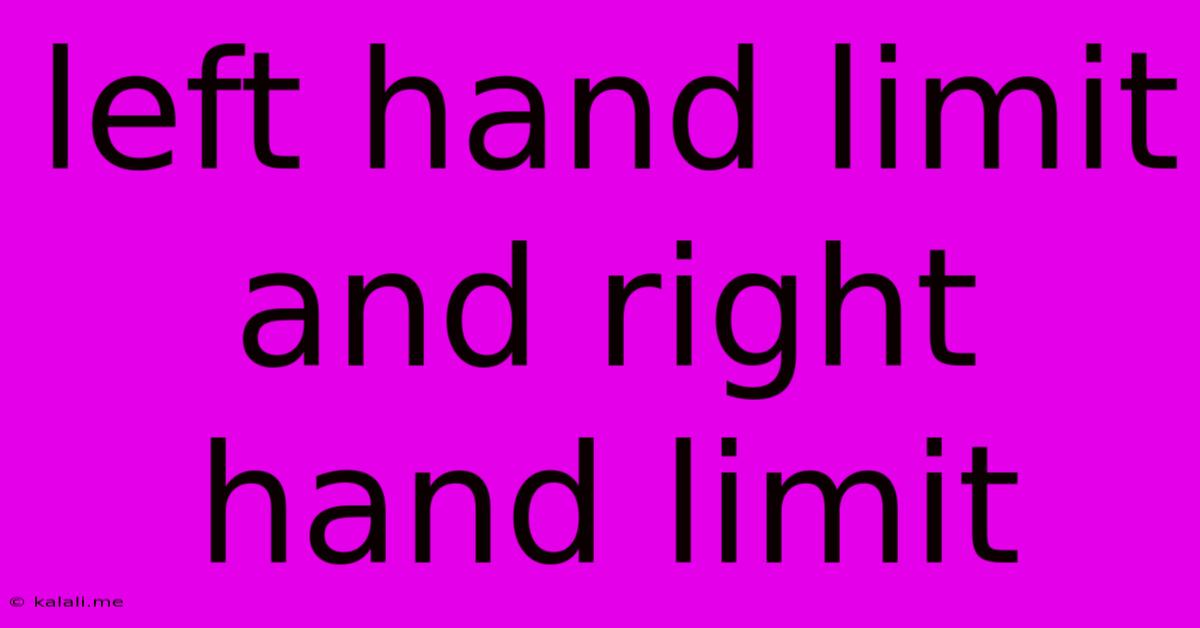Left Hand Limit And Right Hand Limit
Kalali
Jun 12, 2025 · 3 min read

Table of Contents
Understanding Left-Hand and Right-Hand Limits: A Comprehensive Guide
Understanding limits is fundamental to calculus. While the concept of a limit might seem straightforward at first, it's crucial to grasp the nuances, especially when dealing with piecewise functions or functions with discontinuities. This article delves into the concepts of left-hand limits and right-hand limits, providing a clear explanation with examples to solidify your understanding. This guide will help you master these concepts and prepare you for more advanced calculus topics.
What is a Limit?
Before diving into left-hand and right-hand limits, let's briefly revisit the basic definition of a limit. The limit of a function f(x) as x approaches a value c, denoted as lim<sub>x→c</sub> f(x) = L, means that the function's value gets arbitrarily close to L as x gets arbitrarily close to c, but not necessarily equal to c. The function doesn't even need to be defined at c for the limit to exist.
Introducing Left-Hand and Right-Hand Limits
The existence of a limit at a point depends on the behavior of the function from both sides of that point. This is where the left-hand limit and the right-hand limit come into play.
-
Left-Hand Limit: The left-hand limit of a function f(x) as x approaches c from the left (i.e., values of x less than c) is denoted as lim<sub>x→c<sup>-</sup></sub> f(x) = L. This means the function approaches L as x approaches c from values smaller than c.
-
Right-Hand Limit: The right-hand limit of a function f(x) as x approaches c from the right (i.e., values of x greater than c) is denoted as lim<sub>x→c<sup>+</sup></sub> f(x) = L. This indicates the function approaches L as x approaches c from values larger than c.
The Relationship Between Limits and One-Sided Limits
A standard limit exists at a point c only if both the left-hand limit and the right-hand limit exist and are equal. In other words:
lim<sub>x→c</sub> f(x) = L if and only if lim<sub>x→c<sup>-</sup></sub> f(x) = lim<sub>x→c<sup>+</sup></sub> f(x) = L
If the left-hand and right-hand limits are not equal, the limit at c does not exist. The function might have a jump discontinuity or other types of discontinuities at that point.
Examples Illustrating Left-Hand and Right-Hand Limits
Let's illustrate these concepts with some examples:
Example 1: A Continuous Function
Consider the function f(x) = x². Let's find the left-hand and right-hand limits as x approaches 2.
- lim<sub>x→2<sup>-</sup></sub> f(x) = lim<sub>x→2<sup>-</sup></sub> x² = 4
- lim<sub>x→2<sup>+</sup></sub> f(x) = lim<sub>x→2<sup>+</sup></sub> x² = 4
Since both limits are equal to 4, the limit lim<sub>x→2</sub> x² = 4 exists.
Example 2: A Function with a Jump Discontinuity
Consider the piecewise function:
*f(x) = { x + 1, if x < 1 { x², if x ≥ 1
Let's examine the limits as x approaches 1:
- lim<sub>x→1<sup>-</sup></sub> f(x) = lim<sub>x→1<sup>-</sup></sub> (x + 1) = 2
- lim<sub>x→1<sup>+</sup></sub> f(x) = lim<sub>x→1<sup>+</sup></sub> x² = 1
Since the left-hand limit (2) and the right-hand limit (1) are different, the limit lim<sub>x→1</sub> f(x) does not exist. This function has a jump discontinuity at x = 1.
Conclusion
Understanding left-hand and right-hand limits is crucial for analyzing the behavior of functions, particularly around points of discontinuity. By carefully examining the function's approach from both sides of a point, we can determine whether a limit exists and identify different types of discontinuities. This fundamental concept forms the basis for many further explorations in calculus and its applications.
Latest Posts
Latest Posts
-
Three Phase Induction Motor Circuit Diagram
Jun 13, 2025
-
How To Subtract Two Columns In Excel
Jun 13, 2025
-
How To Print The Act Admission Ticket
Jun 13, 2025
-
The First Step In Decision Making Is To
Jun 13, 2025
-
Si Unit For Volume Of A Liquid
Jun 13, 2025
Related Post
Thank you for visiting our website which covers about Left Hand Limit And Right Hand Limit . We hope the information provided has been useful to you. Feel free to contact us if you have any questions or need further assistance. See you next time and don't miss to bookmark.